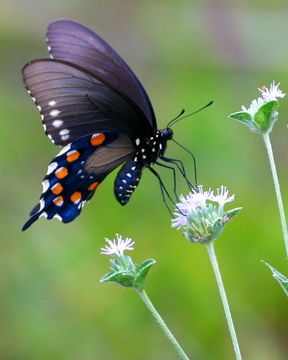Adaptation
Batisian Mimicry
The Red-Spotted Purple butterfly
strategically looks very similar to the poisionous Pipevine
Swallowtail, Battus philenor. Although the
Red-Spotted Purple is not poisonous, looking like a toxic
butterfly works to their advantage by keeping away predators
such as birds
(Macy and Shepard, 11). Red-Spotted Purple butterflies
became more similar to the Pipevine Swallowtail overtime because
of natural selection. Having the coloring of a poisonous
species deters predators and allows for a longer life
expectancy, thus creating a higher reproduction rate.


Red-Spotted Purple Butterfly
Pipevine Swallowtail
Proboscis
The Red-Spotted Purple
butterfly, along with most of the Lepidoptera butterfly family has a proboscis.
The proboscis is a structure made up of two tubes (galeae) located on the
maxillae that come together to form a central tube. It is used much like a
straw; the butterfly uses a sucking action to retrieve nutrients. The
proboscis is coiled up under the butterfly's head while resting and is extended
only during feeding
(Scoble, 6). The proboscis is an ideal tool for the
Red-Spotted Purple butterfly because it can easily pierce their food source and
obtain the nutrients.